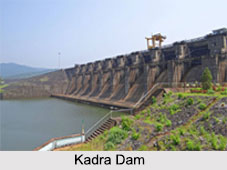 Located in the Uttara Kannada district of the state of Karnataka, the Kadra Dam was constructed in the year 1997 in the Tapi and Tandra river basin across the River Kalinadi. Sanding at a height of about 133 ft, the Kadra Dam is an earthen dam that spreads for a length of 2,313 metres. The dam is the integral part of the Kaiga Project that incorporates several innovative design features - common as well as site specific. The Kadra power house has been built on the left bank of the Kalinadi River with an installed capacity of 150 MW and provides adequate water to meet the total plant water requirement. The power house integrates three 50 MW Kaplan turbines which are coupled to the generating units. The annual generation is 570 MU and the design head is 32 m.
Located in the Uttara Kannada district of the state of Karnataka, the Kadra Dam was constructed in the year 1997 in the Tapi and Tandra river basin across the River Kalinadi. Sanding at a height of about 133 ft, the Kadra Dam is an earthen dam that spreads for a length of 2,313 metres. The dam is the integral part of the Kaiga Project that incorporates several innovative design features - common as well as site specific. The Kadra power house has been built on the left bank of the Kalinadi River with an installed capacity of 150 MW and provides adequate water to meet the total plant water requirement. The power house integrates three 50 MW Kaplan turbines which are coupled to the generating units. The annual generation is 570 MU and the design head is 32 m.
During the monsoon season between the months of June to September, the area around the Kadra Dam normally experiences heavy rainfall measuring up to approximately 4,600 mm. The temperature varies between a minimum of 15° C to a maximum of 42° C, with a relative humidity ranging between 66% to 80%.
The area around the dam does not entertain fishing or agriculture but there are few nearby attractions which are a treat for the travellers visiting around this place. The temples of Naganath and Durga Devi, and the fort of Kot Shiveshwar along with the Sadashivgad fort are popular tourist spots. The tortoise shaped island of Kurumgad where aquatic animals like dolphins and otters can be found are also major tourist attractions in this area. There are also several other attractions close to the Kadra Dam; they are the Sanyasi Island, Devbagh Island, Dandeli Wildlife Sanctuary, and Benne Hole Falls etc.
This article is a stub. You can enrich by adding more information to it. Send your Write Up to content@indianetzone.com



















